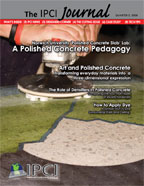Art and Polished Concrete?
Transforming Everyday Materials into a Three-Dimensional Expression
by Sharon Harry
Sculpture can transform an ordinary material into a three-dimensional expression that must be physically experienced to have meaning. This is student artist Valeria Yamamoto’s belief, and her sculpture was created to be as interactive as possible.
"I just wanted people to want to touch it," claims the Florida International University Art Graduate, speaking of the polished concrete used to create "Seawhisper", the seven foot tall sculpture resembling a large conch shell that was first revealed at FIU’s BFA exhibit at the Patricia & Phillip Frost Art Museum. The polished concrete finish lends the sculpture a light wet look; an esthetic that is synonymous with maritime. With the ocean as the core inspiration for "Seawhisper", the organic shapes serve as a reminder of the beach, with the intention of producing a calming effect, even in all the hustle and bustle of urban life.
At first, Yamamoto was concerned that the placement of "Seawhisper", in an outdoor corridor, would be remote; that too few people would get to see the sculpture. However, the massive size, fluid shape and unique finish of the piece drew onlookers to it with interest. "People in the space are part of the sculpture." Yamamoto explained. Yamamoto dedicated a good deal of time working to finish the interior curvature of the ‘shell’, even experimenting with the form in an attempt to recreate the acoustic resonance of the waves (that shells on the beach are said have when they are touched by the wind). "The opening was not right, but you do get a shooshing echo from listening to it!"
"Many other materials were not suited to her needs," remarks Dr.. R. F. Buckley, Sculpture Professor and Head of Sculpture Department at FIU and mentor to Yamamoto. Dr.. Buckley declared that even though plaster is a very popular choice among students for this type of work, its very soft nature could not withstand the elements once placed in an outdoor corridor. Buckley goes on to state that the right material would be a product that could be built up, similar to a plaster, and would, "…meet the rigors of the structure and [of the] elements." Polished concrete was the obvious choice; the concrete being durable enough to display outdoors, the polish making it visually inviting and impossible not to touch.
Creating a sculpture demands a great deal of physical effort be given by the creator to ensure success. "I wasn’t sure how it would work," Yamamoto reveals. "With a painting, you have a feeling. With a sculpture, you have gravity. Gravity doesn’t always cooperate." As those in the concrete industry know, concrete can be a challenge to work with, and temperamental based on many factors; such as the surrounding weather. Not a problem for a painter, but a huge problem when sculpting and polishing. "There were many problems to solve during the process. With a painting, humidity doesn’t affect it. You don’t have to worry about your piece breaking." Through dedication and hard work, Yamamoto met the physical challenges of molding the concrete head on and defeated the problems that presented themselves during the formation and polishing process.
Yamamoto stated that she would like to work with polished concrete again. Mentioning the unique qualities of concrete, "I most like the texture. [I like the] irregularities in the concrete. It is natural, not plastic, and has the quality of stone. It is cold but it changes color when it is wet." Dr.. Buckley has little doubt about Yamamotos future success as a working artist, and describes her as a ‘dynamo’. "Take a group of people and Valeria makes teaching worth while…She makes good art, and works at it everyday."
"Seawhisper" is on display at the Third Biennial Sculpture Exhibition in Chattanooga, TN, from August 2008 – February 2010.

